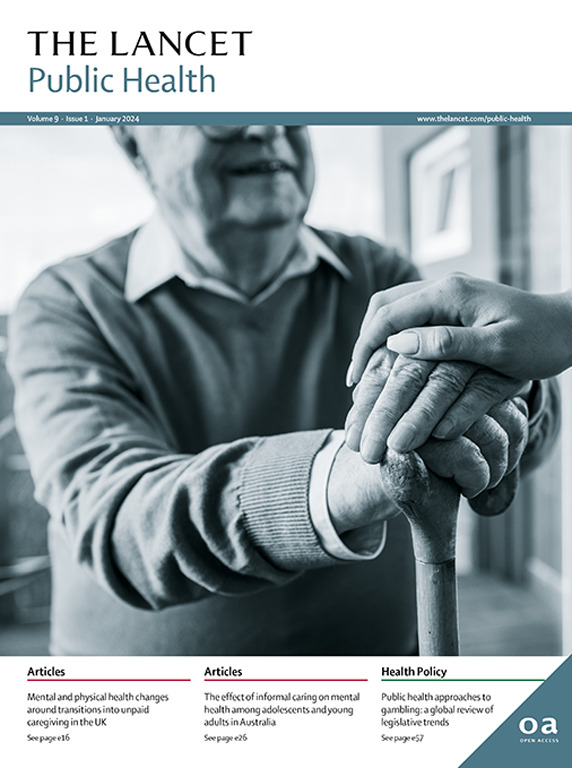State of health and inequalities among Italian regions from 2000 to 2021: a systematic analysis based on the Global Burden of Disease Study 2021
IF 25.4
1区 医学
Q1 PUBLIC, ENVIRONMENTAL & OCCUPATIONAL HEALTH
引用次数: 0
Abstract
Background
Over the past two decades, the Italian National Health Service has been gradually decentralised, with Italy's 21 regional governments now responsible for managing their health services. This change, coupled with austerity measures and a steadily ageing population, has adversely affected universal health coverage and equity, exacerbating inequalities and regional disparities. This study aimed to analyse time trends and subnational differences in the burden of disease from 2000 to 2019, and from 2019 to 2021 to capture the effects of the COVID-19 pandemic.Methods
This study uses estimates for Italy from the Global Burden of Diseases, Injuries, and Risk Factors Study 2021. We analyse trends and geographical differences in disease burden from 2000 to 2021. Metrics include life expectancy, health-adjusted life expectancy (HALE), years lived with disability (YLDs), years of life lost (YLLs), and disability-adjusted life-years (DALYs) observed at national, macroregional, and subnational levels. Percent changes in rates, with both all-age and age-standardised rates, and 95% uncertainty intervals (95% UIs) are reported.Findings
Life expectancy at birth in Italy increased from 79·6 years in 2000 to 83·4 years in 2019, dropped to 82·2 years in 2020 due to COVID-19, and recovered slightly to 82·7 years in 2021. HALE was 70·9 years (95% UI 67·4–73·8) in 2021. Substantial regional disparities were observed: in general, despite higher YLD rates, northern regions had better health outcomes, with higher life expectancy and HALE and lower YLL rates compared with southern regions. Overall, the top causes of YLDs were low back pain (1556·5 [1098·5–2080·2]), falls (926·2 [638·8–1253·8]), and headache disorders (858·0 [173·7–1808·2]). Anxiety and depressive disorders both had substantial increases in the period from 2019 to 2021 (19·8% and 17·3%, respectively). YLDs for Alzheimer's disease and diabetes increased substantially from 2000 to 2019 and 2019 to 2021 (70·6% and 3·0% for Alzheimer's disease and 46·8% and 7·9%, respectively for each timepoint). YLL rates declined for ischaemic heart disease from 2000 (–29·9% in 2019), but increased for Alzheimer's disease and other dementias (54·5%). DALY rates decreased overall from 2000 to 2019, but rose again in 2021 due to the COVID-19 pandemic.Interpretation
The study highlights considerable regional disparities in Italy's health outcomes, driven by demography, heterogeneous health service quality, and economic inequalities. Addressing the increasing burden of Alzheimer's disease, diabetes, and mental health disorders, as well as regional disparities, requires strengthened preventive measures, equitable health service access, and socioeconomic policies, both at the national and regional levels.Funding
Bill & Melinda Gates Foundation.2000年至2021年意大利各地区的健康状况和不平等现象:基于《2021年全球疾病负担研究》的系统分析
背景在过去的二十年里,意大利国家卫生服务逐步下放,由意大利的21个地区政府负责管理各自的卫生服务。这一变化,加上紧缩措施和人口稳步老龄化,对全民健康覆盖和公平产生了不利影响,加剧了不平等和区域差距。本研究旨在分析2000年至2019年以及2019年至2021年期间疾病负担的时间趋势和地方差异,以了解COVID-19大流行的影响。方法本研究使用了2021年全球疾病、伤害和风险因素负担研究中对意大利的估计。我们分析了2000年至2021年疾病负担的趋势和地理差异。指标包括在国家、宏观区域和国家以下各级观察到的预期寿命、健康调整预期寿命(HALE)、残疾生活年数(YLDs)、生命损失年数(YLLs)和残疾调整生命年数(DALYs)。报告了所有年龄和年龄标准化比率的百分比变化,以及95%的不确定性区间(95% UIs)。意大利出生时预期寿命从2000年的79.6岁增加到2019年的83.4岁,由于COVID-19的影响,2020年降至82.2岁,2021年略有回升至82.7岁。2021年HALE为70·9岁(95% UI为67·4 - 73.8)。观察到巨大的区域差异:总体而言,尽管儿童死亡率较高,但北部地区的健康状况较好,与南部地区相比,预期寿命和HALE较高,儿童死亡率较低。总体而言,导致YLDs的主要原因是腰痛(1556·5[1098·5 - 2080·2])、跌倒(926·2[638·8 - 1253·8])和头痛(858·0[173·7-1808·2])。焦虑和抑郁障碍在2019年至2021年期间均大幅增加(分别为19.8%和17.3%)。从2000年到2019年和2019年到2021年,阿尔茨海默病和糖尿病的YLDs大幅增加(每个时间点阿尔茨海默病分别为73.6%和3.0%,46.8%和7.9%)。缺血性心脏病的YLL率从2000年开始下降(2019年为- 29.9%),但阿尔茨海默病和其他痴呆症的YLL率上升(54.5%)。从2000年到2019年,DALY率总体下降,但由于COVID-19大流行,2021年再次上升。该研究强调了意大利健康结果的相当大的地区差异,这是由人口统计学、不同的卫生服务质量和经济不平等驱动的。要解决阿尔茨海默病、糖尿病和精神健康障碍日益加重的负担以及区域差异,需要在国家和区域两级加强预防措施、公平获得保健服务和社会经济政策。FundingBill,梅琳达·盖茨基金会。
本文章由计算机程序翻译,如有差异,请以英文原文为准。
求助全文
约1分钟内获得全文
求助全文
来源期刊

Lancet Public Health
Medicine-Public Health, Environmental and Occupational Health
CiteScore
55.60
自引率
0.80%
发文量
305
审稿时长
8 weeks
期刊介绍:
The Lancet Public Health is committed to tackling the most pressing issues across all aspects of public health. We have a strong commitment to using science to improve health equity and social justice. In line with the values and vision of The Lancet, we take a broad and inclusive approach to public health and are interested in interdisciplinary research.
We publish a range of content types that can advance public health policies and outcomes. These include Articles, Review, Comment, and Correspondence. Learn more about the types of papers we publish.
 求助内容:
求助内容: 应助结果提醒方式:
应助结果提醒方式:


